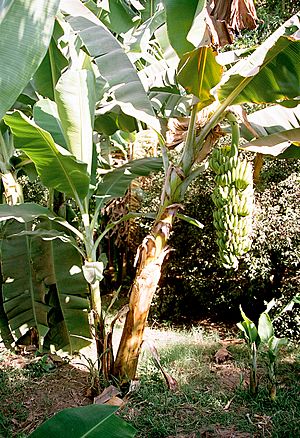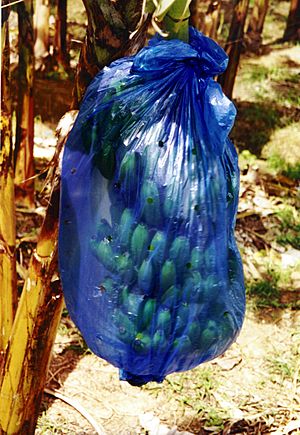Banana production in the Caribbean facts for kids
Growing bananas is a big deal across the Caribbean. Both small family farms and large land owners grow them. A banana plant is a perennial plant, meaning it lives for more than two years. Farmers plant bananas by themselves or mixed with other crops, like in Jamaica. Many countries in the Caribbean and nearby areas rely on bananas as a main export. These include Belize, Costa Rica, Dominican Republic, Honduras, Jamaica, Guadeloupe, Dominica, Martinique, Saint Lucia, Saint Vincent and the Grenadines, Grenada, Trinidad and Tobago, Nicaragua, Panama, Suriname, and Colombia.
Contents
How Bananas Are Grown
Growing bananas needs careful planning and the right conditions. Farmers follow specific steps to make sure the bananas grow well.
What Bananas Need to Grow
Bananas need certain things to grow big and healthy:
- Temperature: Bananas love warm weather. The best temperature is between 26 to 31 degrees Celsius (79 to 88 degrees Fahrenheit). It should not get colder than 11 degrees Celsius (52 degrees Fahrenheit).
- Rainfall: Plenty of rain is important. Bananas need at least 1750 millimeters (about 69 inches) of rain each year. This rain should be spread out evenly.
- Land: The land should not be too high up. Bananas grow best below 300 meters (about 984 feet) in altitude. Valleys that are protected from strong winds are good spots. This is because banana plants have shallow roots and can easily fall over in strong winds.
- Soil: Bananas like light, slightly acidic soil. Clay and alluvial soils (rich soils left by rivers) are also good.
Getting the Land Ready
Before planting, farmers prepare the land. On gentle slopes, machines are used to dig and turn the soil. On flat land, farmers use a tool called a harrow to break up the soil. This helps make the soil fertile again.
How Bananas Are Planted
Banana plants are grown from their roots or from small shoots called suckers. It takes about one year for a plant to grow bananas. Each planting area usually has one main plant that produces fruit. When the bananas start to grow in a bunch, farmers cover them. They put a plastic bag over each bunch and treat it with bug spray. This helps protect the bananas from diseases and insects.
Picking and Moving Bananas
When a banana bunch is about 12 months old, it's ready to be picked. Farmers cut the bunch from the tree while the bananas are still green. One worker cuts the tree near the bottom, and another catches the heavy bunch. The top part of the cut plant is left on the ground to become mulch, which helps the soil. New banana plants will grow from the underground stems called rhizomes.
After picking, workers often carry the banana bunches on their heads to the nearest road. From there, trucks take the bananas to a packing shed. Some farms use special cable ways to move the bunches to the packing shed. At the shed, only the best bananas are chosen for export. Since bananas spoil quickly, it's very important to pick them at the right time. They must be cut within a week to be ready for shipping.
Getting Bananas Ready for Export
At the packing plant, the chosen bananas are taken off their stalks by hand. Then, they are put into tanks of water for at least four minutes. This washes off any sticky sap (latex) and dirt. Workers are very careful not to damage the banana skins. The bananas are often wrapped in special paper and plastic bags. This helps absorb the sap and protects the fruit.
At the port, the bananas are checked for quality. They are weighed and then put into special refrigerated rooms on ships. These rooms are kept at a cool 13 degrees Celsius (55 degrees Fahrenheit). The air in these rooms is changed regularly. This helps remove gases that the bananas produce naturally. This way, the bananas can travel long distances by sea and arrive fresh. Shipping plans are made about eight weeks in advance.
Why Bananas Are Important
The banana industry is very important for many Caribbean countries. It brings in a lot of foreign money and creates many jobs.
For example, in 1998, Dominica earned about EC$40 million from bananas. In 1999, Saint Lucia earned about EC$87.6 million. These earnings help the countries' economies.
Growing bananas also provides many jobs, especially in rural areas. It takes a lot of people to grow, pick, and pack bananas. In Dominica, the banana industry is the second biggest employer after the government. It gives work to about 6,000 farmers and 700 people at packing plants. In Saint Lucia, about 10,000 people work in the banana industry. In St. Vincent, there are about 5,000 banana growers.
Cool Ways We Use Bananas
Bananas are super versatile! Here are some ways they are used:
- We eat them when they are ripe, often in fruit punches.
- They can be made into banana flour, baby food, banana chips, banana bread, wine, banana porridge, banana paper, and even banana ketchup.
- The stems of banana plants can be used to make cloth.
- Strong ropes can be made from the dried stalks.
- Bananas can also be used as food for animals. This helps countries buy less animal feed from other places.
Challenges for Banana Farmers
Banana farmers in the Caribbean face several problems.
Small Farms and Low Income
Many banana farms are small. This can make it hard to grow bananas efficiently. Small farms often mean farmers earn less money. For example, in Dominica, most of the bananas come from larger farms, even though many small farmers exist. In places like Grenada and St. Vincent, many small farms grow bananas mixed with other crops. Because their farms are small, farmers might not be able to afford fertilizers or protect their crops from pests and diseases. This leads to lower income for them.
High Costs and Competition
Farmers sometimes get low prices for their bananas from shipping and marketing companies. This makes it hard for them to earn enough to improve their farms. The banana industry also has high costs for things like supplies and labor, but the prices farmers get are often low.
Another challenge is competition. Bananas are also grown in large amounts in Latin America and Africa. This means there's a lot of competition for markets like the United Kingdom, which buys many bananas from the Caribbean. If there are too many bananas available, the price goes down. This is a problem because bananas spoil quickly.
Diseases Affecting Bananas
Banana plants can get sick, which causes big problems.
- The Moko disease has caused a lot of damage in Grenada. It even stopped commercial banana growing in Trinidad and Tobago in the 1960s.
- Black sigatoka is another disease that makes bananas ripen too early. It has destroyed a large part of Dominica's banana farms. Even when bananas are exported, some might ripen too early on the ship and arrive in poor condition.



